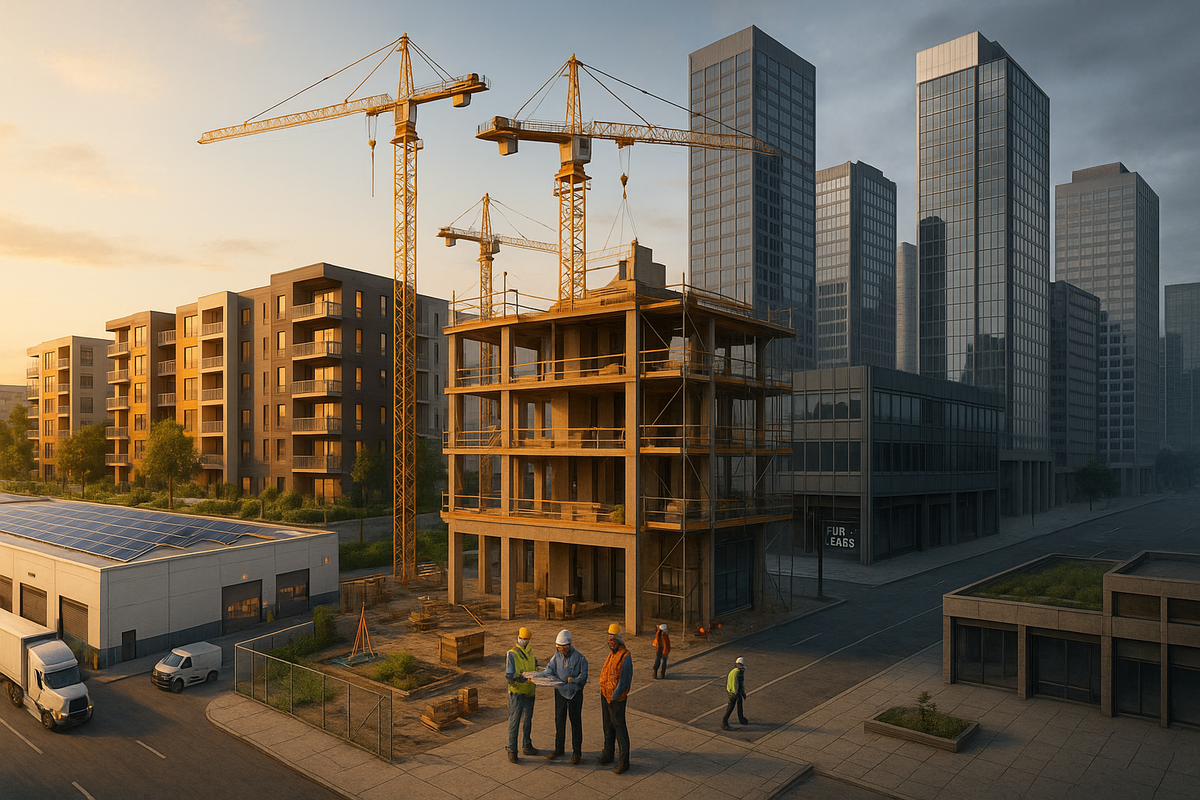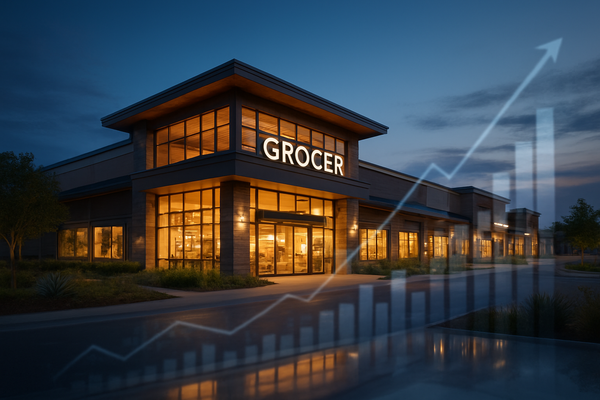Commercial Real Estate's Great Divide: A Tale of Resilience, Repurposing, and Renewed Investment

The commercial real estate (CRE) sector is currently undergoing a profound transformation, moving beyond the turbulence of recent years into a nuanced recovery. This period is marked by a stark divergence in performance: while industrial and living sectors are demonstrating remarkable resilience and robust growth, the traditional office market continues to grapple with unprecedented challenges. Driving this evolving landscape is a gradual but significant increase in investment activity, spurred by the stabilization of borrowing costs and a convergence of buyer and seller expectations, signaling a cautious but palpable optimism for the market's future.
This recovery is not a uniform tide lifting all boats, but rather a strategic realignment. Investors are increasingly favoring properties that align with contemporary economic shifts—e-commerce, demographic changes, and the enduring impact of flexible work models. The market is witnessing a re-evaluation of asset classes, pushing capital towards sectors with strong fundamentals and innovative solutions, while forcing a difficult reckoning for outdated or underperforming properties.
The Great Reset: Why Industrial and Living Thrive While Office Struggles
The commercial real estate market has officially entered a "reset point," with more markets experiencing recovery than recession for the first time in years. Global real estate executives express considerable optimism for 2025, with 88% anticipating higher revenues, driven by an expected improvement in fundamental conditions such as capital availability, property prices, and transaction volumes. This shift is particularly evident in the contrasting fortunes of various property types.
The industrial real estate sector remains a powerhouse, projected to grow from $265.85 billion in 2024 to $279.43 billion in 2025, driven by the relentless expansion of e-commerce, global supply chain optimization, and the rise of third-party logistics (3PLs). While net absorption saw a slowdown in late 2024 and early 2025 (170.8 million square feet for 2024, the lowest since 2011) due to elevated interest rates and new construction, overall demand remains robust. Industrial vacancy rates held steady at 6.8% in Q3 2024 before a slight increase to 6.9% in Q4 2024, still well below historical averages. Rent growth has normalized to 2.8% in 2024, yet specialized segments like cold storage and smaller flex spaces (under 50,000 sq ft) continue to see strong rent growth and low vacancies. New construction starts have significantly decreased, a trend expected to tighten vacancies and support rent growth in 2025.
The living sector, encompassing multifamily and student housing, also demonstrates strong resilience. Multifamily properties are bolstered by persistent renter demand, job growth, and significant housing affordability challenges in the single-family market (average mortgage payments 35% higher than rents). Transaction volumes in multifamily surged by 39.5% year-over-year in Q2 2025. While some Sun Belt markets faced temporary oversupply, occupancy rates are stabilizing at approximately 94.3%, and effective rents are showing signs of renewed growth (projected 3.1% annually over five years). Student housing, in particular, has outperformed, with average rent per bed reaching a record high of $909 in December 2024, driven by strong pre-leasing and demand. New multifamily construction starts are anticipated to be 74% below their 2021 peak by mid-2025, which will help absorb existing supply and support market fundamentals.
In stark contrast, the office market continues its protracted struggle. National office vacancy rates reached a new record high of 20.4% in Q4 2024 and Q1 2025, largely due to the widespread adoption of hybrid and remote work models. This structural shift has permanently altered demand, leading to significant market bifurcation: Class A "trophy" spaces in prime, amenity-rich locations are experiencing a "flight to quality," while older, lower-quality Class B and C properties face deepening challenges, declining valuations, and substantial refinancing risks. Approximately $957 billion in CRE loans are maturing in 2025, many for struggling office properties, posing a "wall of maturities" that could lead to increased defaults. Despite a 5% anticipated increase in overall office leasing volume by late 2025 and some positive absorption in major metros like New York and San Francisco, the sector as a whole continues to navigate a difficult, long-term adjustment.
The Shifting Tides: Who Wins and Who Loses
The current commercial real estate landscape is creating clear beneficiaries and significant challenges for various stakeholders, dependent on their exposure to the performing and struggling sectors. The high interest rate environment and evolving user demands are reshaping investment strategies and company fortunes.
The Winners: Industrial and Living Sector Powerhouses
Companies heavily invested in the industrial and living sectors are largely thriving. The sustained demand for logistics space and housing positions these entities for continued growth.
- Prologis Inc. (NYSE: PLD), one of the world's largest industrial REITs, exemplifies a winner in this environment. With approximately 1.3 billion square feet globally, Prologis benefits directly from e-commerce expansion and optimized supply chains. As of July 2025, the company maintains a high occupancy rate of 94.9% and strong tenant retention, ensuring stable income and projected dividend growth. Its focus on prime logistics corridors and mission-critical distribution centers solidifies its advantageous position.
- Camden Property Trust, a prominent multifamily REIT, has demonstrated strong performance, reporting a 95% occupancy rate for fiscal year 2024 and an average unit rent of $1,997. Its mixed-use properties often integrate community appeal, aligning with evolving urban living preferences.
- Invitation Homes (NYSE: INVH), the largest single-family rental REIT, owning over 85,000 homes, is also well-positioned. The persistent housing affordability crisis continues to drive demand for rentals, making companies like Invitation Homes attractive to investors seeking exposure to the robust living sector.
- Developers and managers of student housing are also significant winners. Firms like The Dinerstein Cos., named the top student housing company for seven consecutive years, and American Campus Communities, which has expanded its portfolio through public-private partnerships with universities like Princeton and MIT, are capitalizing on strong pre-leasing rates and resilient demand in this niche.
The Losers: Office Market Vulnerabilities
Conversely, entities with substantial exposure to the struggling office market, particularly older or lower-quality assets, are facing considerable headwinds.
- SL Green Realty Corp. (NYSE: SLG), a major office landlord in New York City, is frequently cited as a company likely to face ongoing challenges. Its portfolio's exposure to hybrid work models, high vacancy rates in Class B and C assets, declining valuations, and potential foreclosures on maturing debt create significant financial pressures. Office REITs, in general, are expected to see negative earnings changes and the largest decline in Funds From Operations (FFO) growth (negative 21%) in 2024, with some even suspending or cutting dividends.
- Owners of older, lower-quality office buildings: Many private landlords and smaller investment firms, particularly those with portfolios concentrated in Class B and C office spaces in less desirable locations, are struggling with record-high vacancies and the inability to attract new tenants. These properties often require substantial capital for renovations or adaptive reuse, which is challenging to secure in a tight lending environment, leading to increased risk of distress and potential foreclosures.
- Banks with high CRE loan exposure: Regional banks with significant portions of their loan portfolios tied to traditional commercial real estate, especially office properties, face increased credit risk. Rising delinquency rates (Moody's projects office delinquency rates to exceed 14% by 2026) and the "wall of maturities" mean these institutions are dealing with potential loan defaults and the need to offload troubled debt.
While a "flight to quality" offers a silver lining for owners of prime Class A office space, the broader office market remains a significant drag on the CRE sector, forcing widespread strategic reassessments and painful write-downs for many stakeholders.
Beyond Bricks and Mortar: Broader Industry Implications
The commercial real estate sector's recovery and its disparate performance across segments are sending ripple effects far beyond property ownership, impacting construction, finance, urban planning, and regulatory frameworks.
The construction industry is facing a mixed bag. While the robust industrial and living sectors still drive demand for new builds, there's a broader slowdown in new construction across all property types. This is partly offset by a surge in adaptive reuse projects, particularly the conversion of underutilized office buildings into residential or mixed-use spaces. This trend, however, demands specialized construction techniques and often faces complexities with building codes and financing, but can revitalize urban cores and reduce sprawl. The industry also grapples with rising material costs and labor scarcity, which are expected to worsen supply shortages in the coming years.
The financial sector is at a pivotal juncture. The "maturity wall" – nearly $1.8 trillion in CRE loans maturing by the end of 2026 – necessitates extensive refinancing activity. While anticipated interest rate cuts in 2025 are expected to boost lending and sales, banks with significant exposure to struggling CRE, especially office loans, face heightened risks. Regulatory bodies like the Office of the Comptroller of the Currency (OCC) are intensifying scrutiny, demanding robust risk management and stress testing. This environment has seen banks actively offloading troubled debt to private credit funds and institutional investors, leading to a shift in lending dynamics. Meanwhile, Real Estate Investment Trusts (REITs) are projected to generate strong total returns, reflecting investor confidence in their ability to navigate the evolving market.
Urban planning is being fundamentally reshaped. The decline of traditional office demand, coupled with the need for affordable housing, is accelerating urban renewal initiatives focused on adaptive reuse. Cities are exploring policies and incentives to facilitate conversions, creating more walkable, mixed-use environments that integrate residential, retail, and recreational spaces. This trend aims to revitalize central business districts, attract businesses and talent, and generate tax revenue, fundamentally altering urban landscapes to be more dynamic and livable.
From a regulatory and policy perspective, governments are actively engaged. Evolving building codes, zoning laws, and tax regulations are being adapted to support adaptive reuse and incentivize sustainable development. Economic stimulus measures, infrastructure investments, and policies affecting foreign investment also play a crucial role in shaping market liquidity and growth. The emphasis on environmental, social, and governance (ESG) factors is growing, influencing everything from building design to investor capital allocation. Historically, CRE cycles have been driven by factors like inflation, interest rates, and overbuilding. The current cycle, however, is distinct. Compared to the 2007-08 crisis, lending practices are more disciplined, new construction is at historic lows (which helps stabilize values), and the shift in office demand is seen as structural rather than purely cyclical. This means that a general economic upturn alone may not alleviate office vacancies if hybrid work persists, making this recovery unique in its underlying drivers and long-term implications.
The Road Ahead: Navigating a New Normal
The commercial real estate sector is not returning to its pre-pandemic form; rather, it is charting a course towards a "new normal" characterized by adaptation, specialization, and sustained evolution. The next 12-18 months (2025-2026) will largely be defined by cautious optimism and stabilization, while the long-term outlook (3-5 years, 2027-2030) anticipates a period of moderate growth and continued transformation.
In the short-term, interest rates are expected to remain elevated, though with some anticipated easing by the Federal Reserve in 2025, potentially settling around 4.5%. This "higher-for-longer" environment will continue to test the market, especially with the looming "maturity wall" of $1.8 trillion in commercial real estate loans maturing before 2026, posing significant refinancing challenges. Sector-wise, industrial and multifamily will continue their robust performance, while retail shows resilience due to limited new construction. The office market will persist in its bifurcation, with prime assets performing better than older stock, though some major metros are showing early signs of stabilization. Emerging opportunities exist in cold storage, industrial outdoor storage, and the rapidly growing data center segment, fueled by AI.
The long-term outlook suggests that hybrid work models are here to stay, with McKinsey simulations projecting office demand to be 13-38% lower than 2019 levels by 2030, depending on the city. This will drive profound urban transformations, with central districts becoming less solely commercial and more mixed-use, integrating coworking and coliving spaces. Technological integration, particularly Proptech and AI, will become paramount, enhancing operational efficiency and driving demand for specialized infrastructure. Sustainability (ESG) initiatives will gain even greater importance, impacting design, construction, and investment decisions. Demographic shifts, including continued urbanization, will further propel demand in multifamily and mixed-use developments.
Strategic pivots will be essential for all stakeholders. Developers and owners must prioritize repurposing and adaptive reuse, converting vacant office space into residential or specialized facilities. A relentless focus on quality, amenity-rich, and flexible spaces will be crucial for any remaining office stock. ESG integration, technological adoption, and diversification of portfolios into high-growth, resilient sectors (data centers, life sciences, affordable housing) are no longer optional. Proactive debt management and leveraging improving capital markets, including private credit, will be vital to navigate refinancing challenges. City leaders will need to facilitate these shifts through supportive zoning and incentives.
Emerging market opportunities include niche industrial sectors (cold storage, EV battery plants), the burgeoning data center market, life sciences, and persistent demand for affordable and workforce housing. Experiential retail and well-planned mixed-use developments also present significant potential. However, challenges persist, notably the ongoing volatility in the office market, the widespread refinancing risk, rising construction costs, and broader economic uncertainties. Talent shortages in the construction sector will also continue to impact project timelines and expenses.
The future of CRE likely points to a "soft landing" with a segmented recovery as the most probable scenario. The economy avoids a severe recession, interest rates gradually normalize, and the market undergoes a prolonged adjustment rather than a sharp crash. Industrial, multifamily, and certain retail segments continue to perform well, while the office market sees prime assets recover and older stock repurposed or facing distress. This era will reward strategic agility, data-driven decision-making, and a willingness to embrace innovative solutions to fundamentally reshape the built environment.
Conclusion: Adapting to a Transformed Landscape
The commercial real estate market in 2025 stands at a pivotal juncture, firmly on a path of recovery but one that is complex and highly differentiated across its various sectors. The defining characteristic of this period is the stark contrast between the thriving industrial and living segments and the enduring struggles of the traditional office market. This "great divide" is not merely a cyclical fluctuation but a structural evolution, driven by the lasting impacts of e-commerce, demographic shifts, and the fundamental redefinition of the workplace.
The key takeaway for investors and stakeholders is the imperative for strategic adaptation and foresight. Diversification is no longer a luxury but a necessity, with a clear focus on resilient sectors such as industrial, multifamily, healthcare facilities, and the rapidly expanding data center market. Opportunistic investments in distressed office properties, particularly for adaptive reuse into residential or mixed-use developments, represent a challenging but potentially rewarding avenue for those with the expertise and capital. The "flight to quality" in office space, emphasizing prime, amenity-rich assets, underscores the ongoing demand for highly functional and attractive environments that foster collaboration and community.
Moving forward, the lasting impact of these trends will manifest in a permanently altered urban landscape. Hybrid work models will ensure that the demand for traditional office footprints remains below pre-pandemic levels, making adaptive reuse a core strategy for urban revitalization. The dominance of e-commerce will continue to fuel the logistics and industrial sector, solidifying its role as a critical component of global supply chains. Furthermore, the integration of technology (Proptech) and a steadfast commitment to Environmental, Social, and Governance (ESG) principles will become non-negotiable drivers of value, efficiency, and long-term viability across all property types.
Investors should closely monitor several critical indicators in the coming months. These include Federal Reserve policy and interest rate movements, which profoundly impact borrowing costs and capitalization rates; vacancy rates and rent growth across all sectors, especially in the volatile office market; and the successful navigation of the "maturity wall" of commercial mortgage debt. Macroeconomic metrics such as GDP growth, employment rates, and consumer spending will continue to offer broader insights into market health. Ultimately, the commercial real estate market is embarking on a new chapter—one that demands vigilance, innovation, and a profound understanding of evolving demand dynamics to unlock sustainable growth and lasting value.



